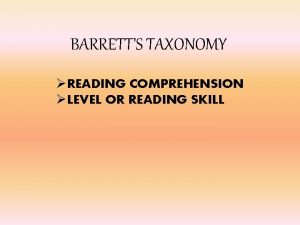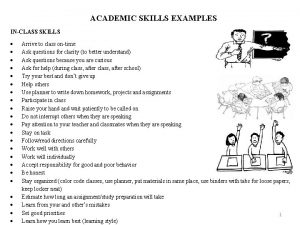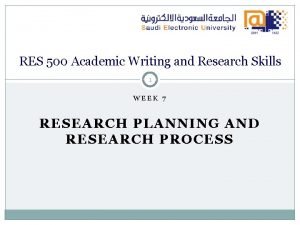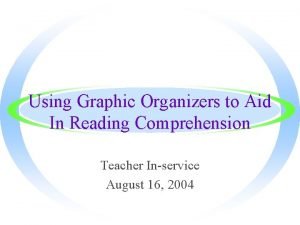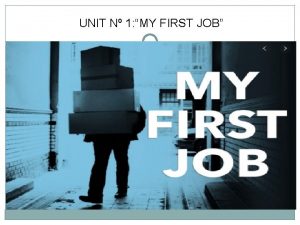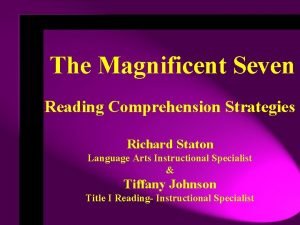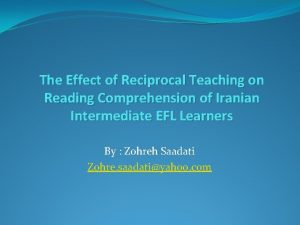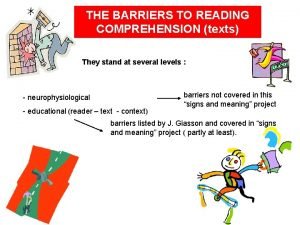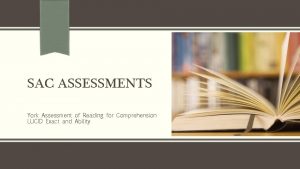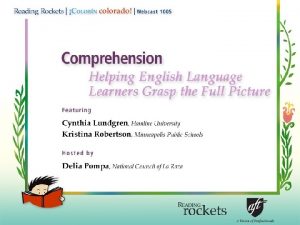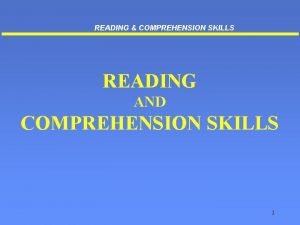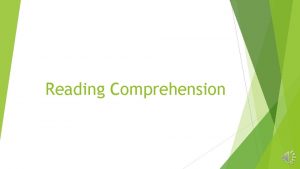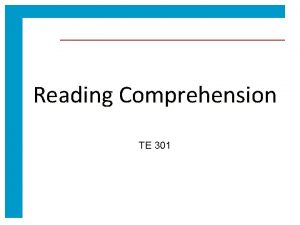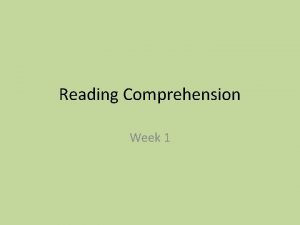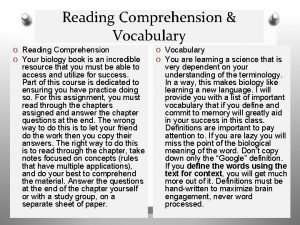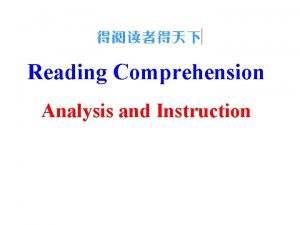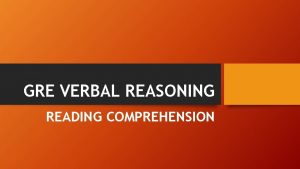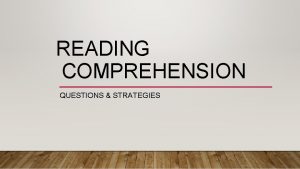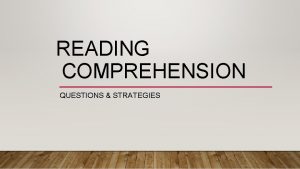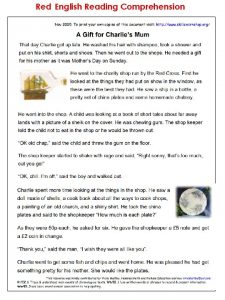Chapter 2 Fundamental Comprehension Skills Academic Reading Fifth














- Slides: 14

Chapter 2: Fundamental Comprehension Skills Academic Reading, Fifth Edition by Kathleen T. Mc. Whorter © 2004 Pearson Education, Inc. , publishing as Longman Publishers

Learning Objectives: To identify what is important in a chapter To learn how to vary your reading rate To learn how to read selectively © 2004 Pearson Education, Inc. , publishing as Longman Publishers

Three Essential Elements of a Paragraph TOPIC: the one thing the paragraph is about, the unifying factor. MAIN IDEA: what the author wants to communicate about the topic, the central or most important thought. The sentence that expresses the main idea is the topic sentence. DETAILS: the proof, support, explanation, reasons or examples that explain the main idea. © 2004 Pearson Education, Inc. , publishing as Longman Publishers

The main idea of a paragraph tells you what the author wants you to know about the topic. Ask these questions: • What key point is the author trying to say about the topic? • Which sentence states the main idea? © 2004 Pearson Education, Inc. , publishing as Longman Publishers

One sentence expresses the main idea. This is called the topic sentence. TOPIC SENTENCE FIRST: A statement made at the beginning and then supported throughout the paragraph. (MOST LIKELY SPOT) TOPIC SENTENCE LAST: The author leads up to the main point and then directly states it at the end. © 2004 Pearson Education, Inc. , publishing as Longman Publishers

Where to find the topic sentence: TOPIC SENTENCE IN THE MIDDLE: Author builds up to the main idea, states it, and then goes on to elaborate on it further. TOPIC SENTENCE FIRST AND LAST: Author states the main idea, supports it, and then restates it again at the end. © 2004 Pearson Education, Inc. , publishing as Longman Publishers

What is the topic sentence of the following paragraph? On election day in 1972, at 5: 30 p. m. Pacific Standard Time, NBC television news declared that Richard Nixon had been reelected president. This announcement came several hours before the polls were closed in the western part of the United States. In 1988, polls in a dozen western states were still open when CBS and ABC announced that George Bush had been elected president. These developments point to the continuing controversy over the impact of election night coverage on voter turnout. (Keefe et al. , American Democracy, p. 186) © 2004 Pearson Education, Inc. , publishing as Longman Publishers

Finding an Implied Main Idea UNSTATED MAIN IDEAS: The reader has to infer, or reason out, what the main idea of the paragraph is. This type of paragraph contains only details or specifics. What is the one thing the author is discussing throughout the paragraph? What would be a sentence to explain all the details? © 2004 Pearson Education, Inc. , publishing as Longman Publishers

Recognizing Primary and Secondary Details Primary details directly explain the main idea. Secondary details provide additional information, offer an example, or further explain one of the primary details MAIN IDEA Primary detail • secondary detail © 2004 Pearson Education, Inc. , publishing as Longman Publishers

Adjusting Your Rate to Meet Comprehension Demands Assess the text’s difficulty. Assess your familiarity with and interest in the subject. Define your purpose Decide what, if any, follow-up activity is required. See Table 2 -1 for Levels of Comprehension and Reading Rates © 2004 Pearson Education, Inc. , publishing as Longman Publishers

Reading Selectively…. When? You are searching for specific information (scanning) A high level of comprehension is not needed. You are familiar with what you are reading. The material does not match your purpose in reading. The writer’s style allows you to skim information (portions). © 2004 Pearson Education, Inc. , publishing as Longman Publishers

Summary Slides While you read paragraphs, focus on identifying three types of information: the main idea primary supporting details secondary supporting details © 2004 Pearson Education, Inc. , publishing as Longman Publishers

Summary Slides The topic sentence can take several positions: first last in the middle first and last implied © 2004 Pearson Education, Inc. , publishing as Longman Publishers

Read the article on art appreciation and complete the exercises at the end of the selection. “Issue-Oriented Art” by Duane Preble and Sarah Preble © 2004 Pearson Education, Inc. , publishing as Longman Publishers
 While reading activities
While reading activities Five fundamental values of academic integrity
Five fundamental values of academic integrity Six fundamental values of academic integrity
Six fundamental values of academic integrity Barrett's taxonomy
Barrett's taxonomy Academic skills examples
Academic skills examples Academic writing and research skills
Academic writing and research skills Inventions inspired by nature
Inventions inspired by nature Story maps for reading comprehension
Story maps for reading comprehension My first job reading comprehension
My first job reading comprehension Jobs and occupations reading comprehension
Jobs and occupations reading comprehension 7 reading comprehension strategies
7 reading comprehension strategies Reading comprehension meaning
Reading comprehension meaning Barriers in reading
Barriers in reading Lucid exact manual
Lucid exact manual Reading comprehension definition
Reading comprehension definition



